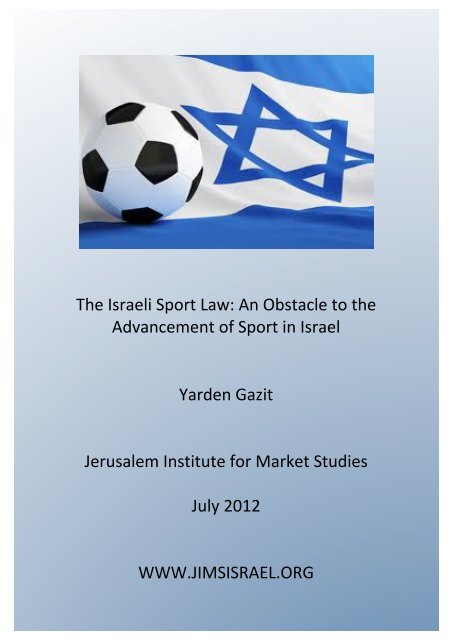Israel's "Sports Law" - Jerusalem Institute for Market Studies
Israel's "Sports Law" - Jerusalem Institute for Market Studies
Israel's "Sports Law" - Jerusalem Institute for Market Studies
You also want an ePaper? Increase the reach of your titles
YUMPU automatically turns print PDFs into web optimized ePapers that Google loves.
The Israeli Sport Law: An Obstacle to the <br />
Advancement of Sport in Israel <br />
Yarden Gazit <br />
<strong>Jerusalem</strong> <strong>Institute</strong> <strong>for</strong> <strong>Market</strong> <strong>Studies</strong> <br />
July 2012 <br />
WWW.JIMSISRAEL.ORG
The Israeli Sport Law: An Obstacle to the Advancement of Sport in Israel <br />
Yarden Gazit <br />
<strong>Jerusalem</strong> <strong>Institute</strong> <strong>for</strong> <strong>Market</strong> <strong>Studies</strong> <br />
July 2012 <br />
Heading into the opening of the London Olympic Games, the state of Israeli sport is on the <br />
public agenda. It is true that the debate focuses on the number of medals to be won and the <br />
type of metal of which they will be made, but clearly the contribution of sports to Israeli <br />
society extends beyond Olympic medals: <strong>for</strong> tens of thousands of Israeli athletes who will <br />
not win an Olympic medal, and <strong>for</strong> hundreds of thousands of amateur athletes, participation <br />
in sport is a way to a healthy lifestyle, and to values such as excellence, playing by the rules, <br />
teamwork, hard work, which are so important to the existence of a healthy and functioning <br />
civil society. <br />
This paper will examine the Israeli government's policy in the field of sport and the obstacles <br />
preventing an increase in the number of Israeli athletes and their achievements. The paper <br />
will reveal that the Israeli <strong>Sports</strong> Law and other regulations put in place by the Culture and <br />
<strong>Sports</strong> Ministry <strong>for</strong>m an obstacle to participation in sport, especially among children. Such <br />
regulations require parents to pay hundreds of Shekels each year <strong>for</strong> an industry of medical <br />
examinations whose effectiveness is questionable and on double and unnecessary insurance <br />
coverage <strong>for</strong> children already insured. In addition, sports regulations restrict the supply of <br />
coaches and instructors, especially in the country's periphery, thereby <strong>for</strong>cing parents to pay <br />
more in money and in time on driving children to sports facilities. The result is that many <br />
children who would otherwise have been interested in participating in a competitive sport <br />
are not doing so <strong>for</strong> economic, logistical or other reasons. The decrease in the number of <br />
athletes naturally reduces the potential of achievements in international competition, as <br />
well as the economic foundation of some of the smaller sports. <br />
In public debates on sport one often hears the claim that low funding <strong>for</strong> sport is the main <br />
obstacle <strong>for</strong> improvement, and that additional funding is the desired solution. This <br />
paper will ignore the budgetary issue and will suggest policy measures which will increase <br />
the number of athletes and their achievements with no additional funding. The paper will <br />
overlook the budgetary issue <strong>for</strong> several reasons: first, as we shall presently see, there are <br />
more significant obstacles to Israeli sport than lack of funding. Second, the government of <br />
Israel faces many challenges, and financial support <strong>for</strong> sport is not high on its priority list. <br />
Even if the government will increase its sport budget, at a time of fiscal crisis it will not <br />
hesitate to cut the budget again, and thus the focus on funding will have achieved little <br />
while preventing more important structural changes from taking place. Third, there is no <br />
evidence to suggest that additional funding <strong>for</strong> an inefficient system will improve its results. <br />
Another claim that is often heard is that the relatively weak per<strong>for</strong>mance of Israeli athletes <br />
in international competitions results from <strong>Israel's</strong> small population. However, the truth is <br />
that even in a comparison of medals per capita (in the 2008 Beijing Olympics), a fairer <br />
T<br />
h<br />
e <br />
I<br />
s<br />
r<br />
a<br />
e<br />
li
criterion <strong>for</strong> countries with small populations such as Israel, Israel ranks only 64 th , while 8 of <br />
the top 10 countries in the ranking have a smaller population than <strong>Israel's</strong>. In any case the <br />
size of the population is much harder to change than government policy, and this paper will <br />
focus on proposing a better alternative to the current policy. <br />
Background <br />
The Number of Athletes <br />
According to the Israeli <strong>Sports</strong> Authority in the Ministry of Culture and <strong>Sports</strong>, there are <br />
64,361 active athletes in Olympic disciplines, less than 1 per cent of the population. <br />
According to Dr. Uri Scheffer, head of the Authority, the share of athletes in Israel is lowest <br />
in the Western world. <br />
Approximately two thirds of athletes in Olympic disciplines are basketball and soccer <br />
players, and the rest, 21,722 athletes, practice one of the remaining 29 Olympic disciplines. <br />
In the third largest sport in terms of active athletes, tennis, there are approximately 3,000 <br />
athletes (5% of the athletes in Israel), while there are less than 100 athletes in each of the 5 <br />
smallest disciplines: rowing, bow and arrow, kayaking, ice skating and skiing. In spite of the <br />
fact that the <strong>Sports</strong> Authority invests a lot of resources in the advancement of female <br />
athletes, the share of women among all athletes is less than 20 per cent, and among junior <br />
athletes it is even lower. Among athletes in individual sports, only 2% are Arab, compared to <br />
20% among the general population. <br />
The small number of athletes in each discipline except basketball and soccer raises two kinds <br />
of difficulties. First, the potential <strong>for</strong> international achievements is limited. Only few athletes <br />
are talented enough to make it to the upper echelons of the sport, and the fewer the <br />
athletes, the smaller the talent pool. It takes many years to develop a young talented athlete <br />
into an Olympian, and many do not fulfill their potential and quit <strong>for</strong> various reasons. <br />
There<strong>for</strong>e in most disciplines a wide base of young athletes is necessary in order that a few <br />
athletes can develop eventually into world-‐class athletes. This conclusion can also be drawn <br />
from the fact that of the 64,361 active athletes, only 38 met the criteria set by the Israeli <br />
Olympic Committee and were chosen to represent Israel in the London Olympics, an <br />
Olympian <strong>for</strong> every 1,694 athletes. Second, the small number of athletes makes it difficult <br />
<strong>for</strong> sports federations to create a stable economic base and recruit sponsors, and there<strong>for</strong>e <br />
leaves them dependent upon limited public funds. <br />
Clearly, one of the main obstacles to the advancement of sport in Israel is the number of <br />
athletes, and any policy whose goal is to advance sport must focus on this issue. <br />
The National Expenditure on Sport <br />
The national expenditure on sport (competitive and recreational) in 2010 was 6.8 billion <br />
Shekels. 87% of this figure was spent by households, while only 13%, some 880 million <br />
Shekels, were invested by public sector organizations. About half of the public expenditure <br />
came from the Council <strong>for</strong> the Regulation of <strong>Sports</strong> Betting, Israel government monopoly on <br />
sports betting. The Ministry of Culture and <strong>Sports</strong>, whose budget was 780 million Shekels, <br />
provided 75 million Shekels <strong>for</strong> sport, about half earmarked <strong>for</strong> recreational sport. The rest
of the funds were spent by municipalities and the national lottery (which invests in sport <br />
facilities). <br />
Even if the share of the government funding <strong>for</strong> sport is small relative to households, <br />
government involvement in competitive sport is not. The government intervenes in sport <br />
through the Sport Law and other strict regulations set by the <strong>Sports</strong> Authority. <br />
The Sport Law <br />
The Israeli Sport Law was passed in 1988, although its regulations did not come into effect <br />
until a decade later. The Law allows the <strong>Sports</strong> Minister to mandate that every person who <br />
wishes to practice coaching or instructing in a particular discipline hold a certification <br />
recognized by the <strong>Sports</strong> Authority. The Law also <strong>for</strong>bids national federations from allowing <br />
athletes to participate in official competitions unless they underwent medical examinations <br />
at a certified sports medicine clinic. The Law authorizes the <strong>Sports</strong> Minister to determine the <br />
type of examination required. In addition, the law requires athletes who wish to participate <br />
in an official sports competition to purchase an accident insurance, the details of the policy <br />
to be determined by the <strong>Sports</strong> Minister. <br />
The Law grants the <strong>Sports</strong> Minister and the <strong>Sports</strong> Authority wide authority. An examination <br />
of the regulations set by them and their consequences reveals that they constitute a <br />
significant obstacle to the advancement of sport in Israel. <br />
Medical examinations <br />
According to Israeli sports regulations, every athlete must go through a general medical <br />
examination conducted by a certified sports doctor in a certified sports medicine clinic every <br />
two years (or every year <strong>for</strong> athletes over 35 years of age), a periodical check-‐up every year, <br />
and an argometric examination (including a cardiac stress test) in the year the athlete has <br />
reached the age of 17, 23, 27, 32, 34 and starting the age of 35, every year. Without having <br />
undertaken such an examination, an athlete may not participate in an official sporting <br />
competition. <br />
In order to be granted the certification of a sports medicine clinic, a clinic must meet the <br />
standards set by the Department of Certification of Medical Institutions and Machinery at <br />
the Ministry of Health. The department sets detailed regulation regarding manpower, <br />
equipment, test protocols etc. which can be found on the Health Ministry's website. <br />
Following the implementation of the regulations, an industry of medical examinations worth <br />
millions of dollars annually has developed. Some 70 sports medicine clinics have been <br />
established throughout the country, of which 12 are mobile clinics, caravans with <br />
examination equipment that travel to any location upon request in order to conduct <br />
examinations. <br />
The cost of tests varies between 90 and 250 NIS, while some of the costs is born by the <br />
athlete's health provider. To these one must add travel costs, since not every town has a <br />
sports medicine clinic. In addition, parents are often obliged to drive children to <br />
examinations during work hours. Travel costs have decreased following the establishment of
mobile clinics, but have not disappeared completely, since mobile clinics serve only groups <br />
of 20 athletes and above. <br />
In practice most Israeli sports federations are small and do not have a bureaucratic system <br />
which is able to distinguish the different kinds of examinations required (argometric cardiac <br />
stress tests, general physical examination and a periodical check-‐up). There<strong>for</strong>e, they are not <br />
able to verify that each athlete has undergone the required examination. Many federations <br />
have chosen to deal with this problem by obliging all of their athletes to undertake the more <br />
expensive cardiac stress test every year. <br />
In addition, each examination is valid <strong>for</strong> one year, but the competition seasons of different <br />
sports federations are often not congruent. An athlete participating in more than one sport, <br />
as often occurs among children, may there<strong>for</strong>e be required to go through more than one <br />
test per year. For example, a child who joins a basketball league and undertakes an <br />
examination in September be<strong>for</strong>e the beginning of the basketball season in October, and <br />
decides after four months to quit and join a cycling team, will have to undertake another <br />
examination in December in order to become a member of the cycling federation, whose <br />
competition season starts in January (since his first examination shall not be valid during the <br />
entire cycling season). <br />
While the cost of the examination may seem low, one must take into account the fact that <br />
children tend to change their hobbies and tastes often, and parents are reluctant to spend <br />
money on activities their child has not yet experienced, or has just begun and may not <br />
continue. This is especially true <strong>for</strong> participation in a competitive sport team, which requires <br />
monthly payment to the team, annual membership fees <strong>for</strong> the national federation, and <br />
often also the purchasing of equipment. Every additional expense required may deter <br />
parents and reduce the number of active athletes. <br />
Research done in Israel and abroad has not been able to show conclusively that cardiac <br />
stress tests are effective in preventing premature death among athletes. Furthermore, <br />
making such tests mandatory <strong>for</strong> athletes may cause harm <strong>for</strong> several reasons: first, there <br />
are many false positives which may result in healthy athletes being "sentenced" to an <br />
inactive lifestyle proven to be unhealthy, or to exercise without the supervision of a coach. <br />
Second, tests may deter amateur athletes from pursuing competitive sport. Third, the high <br />
cost of the test does not pass a cost-‐benefit analysis and yields low returns relative to other <br />
investments in health. <br />
Several questions arise from this situation: first, even though regulations requiring stress <br />
tests have been in place since 1998 and hundreds of thousands of tests have been <br />
undertaken, the Ministry of Health and the Ministry of <strong>Sports</strong> have not conducted any <br />
evaluation of the effectiveness of the tests or their consequences in Israel. Second, the Israel <br />
Defense Force conducts general physical examinations -‐ and not stress tests -‐ <strong>for</strong> every <br />
candidate <strong>for</strong> serving in a combat unit. Such soldiers are exposed to physical ef<strong>for</strong>ts at least <br />
as intense as competitive athletes (and possibly more so) without the supervision of a coach <br />
or a physiology expert. It seems as though it is easy <strong>for</strong> the government to require private <br />
citizens to undertake strict and costly examinations whose effectiveness has not been
evaluated, but when the government has to foot the bill, as in the case of the IDF, the <br />
examinations are found to fail a basic cost-‐benefit analysis. <br />
In 2010, the <strong>Sports</strong> and Culture Ministry has written a proposal to ease the medical <br />
examination requirements. According to the proposal, stress tests shall be mandatory <strong>for</strong> <br />
athletes aged 40 and over, athletes under 40 shall undergo a general physical examination <br />
every two years (and not every year as they are currently required), and athletes in sports <br />
not requiring significant physical ef<strong>for</strong>t shall be exempt from examinations. In an explanation <br />
to the proposal, the Sport and Culture Minster has admitted that "over the years there has <br />
been no proof that the stress tests have reduced sickness or death of athletes," and even <br />
that the current regulations are "a barrier to amateur sport activity." However, the proposal <br />
has not been adopted, <strong>for</strong> reasons the Ministry has not elaborated. <br />
It remains unclear why athletes are required to spend time and money on examinations <br />
even the <strong>Sports</strong> Ministry admits are ineffective. Regarding children, who even currently are <br />
exempt from stress tests but are required to undergo physical examinations at a sports <br />
medicine clinic, the situation is especially questionable. First, if the effectiveness of stress <br />
tests has not been proven, then the effectiveness of superficial examinations lasting a few <br />
minutes per child is even less relevant. Second, the occurrence of death or serious injury <strong>for</strong> <br />
medical reasons during sports competition among children and youth is extremely rare. <br />
Third, family doctors know a child's medical history much better that a sports doctor <br />
meeting the child <strong>for</strong> a brief one-‐time examination. There is no reason to prevent an active <br />
child with the authorization of a family doctor from participating in a sports competition, nor <br />
is there reason to require his parents to pay <strong>for</strong> the authorization of an additional doctor. <br />
Accident Insurance <br />
<strong>Sports</strong> regulations require federations to verify that every athlete has an accident insurance <br />
prior to participating in an official competition. The amount of coverage is also specified. In <br />
practice, athletes are required to purchase insurance independently or through their team, <br />
at a cost varying between 100 and 475 Shekels per year, depending on the sport and the size <br />
of the team. <br />
It is important to note that according to the requirement of the Ministry of Education, <br />
students in recognized schools are already insured by their municipality. Their insurance is <br />
paid by their parents through school payments. The insurance covers students <strong>for</strong> any <br />
accident "anywhere in Israel and its territories and anywhere else in the world, at any hour <br />
of the day, whether it is related to school activity or not." However, since the policy is a <br />
group policy and the child's name does not appear on it, it does not meet The Sport Law's <br />
regulations. <strong>Sports</strong> federations there<strong>for</strong>e require parents to purchase an additional <br />
insurance policy, upon which the child's name will appear, in order <strong>for</strong> them to participate in <br />
competitions. <br />
A similar problem exists among college and university students, who are insured by their <br />
student union as part of their union dues. Students are a particularly important group in <br />
Israel since mandatory military service cuts the athletic career of most teenagers (save the <br />
few who are granted an active or excelling athlete status in the military and are allowed to
continue their careers). In order to create a wide enough base of athletes, it is necessary to <br />
make sure that many students return to practice their sport after they are released from the <br />
military. The low income level of the average student means that any additional cost may <br />
deter students from practicing competitive sport. <br />
It seems that child-‐ and student-‐ athletes in Israel are <strong>for</strong>ced to pay <strong>for</strong> two insurance <br />
policies while they only need one. This causes an unnecessary expenditure of several <br />
hundred Shekels per year, which may deter many from practicing competitive sport. <br />
Certification of Coaches and Instructors <br />
<strong>Sports</strong> regulations require that every person who wishes to coach or instruct in one of 58 <br />
sport disciplines hold a certification <strong>for</strong> that discipline. For 15 sports, an instructor certificate <br />
suffices in order to instruct all age groups, while in the rest of the disciplines an instructor <br />
may instruct only children aged 16 and under, and a coaching certificate is necessary in <br />
order to coach adults. In order to obtain a coaching certificate one must first hold an <br />
instructor certificate. The structure and program of each course is approved by a supervisor <br />
at the Department of Coach and Instructor Training at the <strong>Sports</strong> Authority. <br />
The length of an average instructor course recognized by the Authority is 236 academic <br />
hours, and the average costs is 5,141 Shekels. The length of an average coaching course is <br />
508 academic hours, and the cost is 10,728 Shekels. Thus, in order to become a coach, one <br />
must invest a total of 744 academic hours and 15,869 Shekels. <br />
Every athlete and parent desires, of course, that the person coaching or instructing them or <br />
their children is professional and knowledgeable. However, setting such a high standard <strong>for</strong> <br />
all disciplines without allowing flexibility creates several problems. First, the number of <br />
hours or money invested does not guarantee the quality of the course. Many countries do <br />
not supervise coaching courses, among them the US, Canada, New Zealand and others. <br />
There is no evidence that coaches in Israel are more professional or skilled than coaches in <br />
those countries. Second, in small sports where demand and economic viability are already <br />
unstable, setting such a high standard reduces the supply of coaches beyond the level which <br />
would have existed in a free market. <br />
The strict regulations result in the fact that in 19 of the 34 sport disciplines in which a <br />
coaching certificate is required in order to coach adults, no such course is available in the <br />
market. In addition, among 24 disciplines in which coaching courses exist, there are coaching <br />
courses outside the country's central district in only 2 disciplines – basketball and horseback <br />
riding. All other courses are offered only in the country's central districts. <br />
This policy has contributed to the creation of a negative cycle which reduces participation in <br />
sports. In small disciplines, the expected income <strong>for</strong> coaches is already small. The high cost <br />
of a coaching course recognized by the <strong>Sports</strong> Authority prevents potential coaches, who <br />
may otherwise have been interested, from attending the course, since they do not believe <br />
there will be a return <strong>for</strong> their investment. The reduced demand <strong>for</strong> coaching courses makes <br />
the organization of such courses economically unviable, and there<strong>for</strong>e reduces the supply of <br />
courses, especially in the periphery. This in turn makes it even more costly <strong>for</strong> potential
coaches who reside in peripheral areas to attend coaching courses, since they now have to <br />
spend time and money on transportation, and reduces the supply of coaches even further. A <br />
reduced supply of coaches means there are less sports activities available to children, and <br />
parents are required to spend more time and money on transportation to towns that still <br />
provide sports activities. Many parents are unable to do so, and there<strong>for</strong>e give up and do <br />
not send their children to a competitive sports activity. This reduces still further the demand <br />
<strong>for</strong> coaches, and so on. <br />
Furthermore, in small disciplines where there are no well organized and well established <br />
sports clubs and teams, coaches also per<strong>for</strong>m the function of entrepreneurs. They establish <br />
teams, market the activity and recruit children, recruit sponsors and thus create a sporting <br />
activity where previously there was none. When regulations reduce the number of coaches, <br />
they there<strong>for</strong>e reduce the number of entrepreneurs who recruit children to sporting <br />
activities, as well as the opportunities available to children and the probability they will <br />
pursue their interest in sport. <br />
It seems that sports federations would be better suited to set their own standards <strong>for</strong> <br />
certification of coaches and instructors. Federations have better in<strong>for</strong>mation on the demand <br />
<strong>for</strong> coaches and will be able to set the necessary level of knowledge and skill necessary <strong>for</strong> <br />
coaches in each specific discipline. Some federations may ease the requirements, which may <br />
cause a decrease in the level of skill and knowledge of the average coach, but this is a price <br />
worth paying in order to increase the number of athletes. Presumably, there are many <br />
parents who would prefer that their child participate in a sporting activity under the <br />
supervision of a certified yet less knowledgeable coach when the alternative is that he sit <br />
idle since there is no one to give him a ride to the neighboring town or since the family <br />
cannot af<strong>for</strong>d to pay the sports club. Experience is much more important in sport than <br />
theoretical education, and if the supply of coaches would be increased and they would be <br />
allowed to gain experience more easily, the quality of coaches will eventually increase, as <br />
will the talent pool <strong>for</strong> senior coaches. <br />
Further Laws and Regulations <br />
All the above has shown that the Sport Law harms Israeli sport. However, it is not the only <br />
piece of such damaging regulation. In recent years additional initiatives to the regulation of <br />
sport have created further damage. The Forbidding of Violence in Sport Law, <strong>for</strong> example, <br />
which was enacted in 2008 at the initiative of the <strong>Sports</strong> Authority, obliges the organizer of <br />
any sporting event to request and receive a business license from their municipality. <br />
Organizers of events with over 200 spectators must hire private security personnel certified <br />
by the <strong>Sports</strong> Authority, as well as an event manager who meets the requirements of the <br />
Authority. The Law does not distinguish between sports or locations where violent events <br />
have occurred in the past or are prone to occur, and other events, and requires all events to <br />
meet its standard. <br />
The Law's requirements increase the costs of organization of sports events, since only a few <br />
security companies employ certified personnel, and those are located in the country's center <br />
or in major cities. At the end of 2011, a total of 1,600 personnel have been certified, while <br />
the police's requirements <strong>for</strong> security personnel often exceed 250 or 300 <strong>for</strong> a single soccer
match. Due to the shortage, companies charge more <strong>for</strong> certified security personnel than <br />
<strong>for</strong> uncertified personnel. Of course, they charge extra <strong>for</strong> transportation in case the event is <br />
held in the periphery. The result is that the organizers of events in small disciplines or in the <br />
periphery, who are already approaching the lower limit of economic viability, are <strong>for</strong>ced to <br />
cancel events or to break the law, while not a single violent incident has ever occurred in <br />
their events. <br />
Another proposal authorized by the Knesset (<strong>Israel's</strong> parliament) and in the process of <br />
implementation is the Establishment of a National Council <strong>for</strong> Sport Law, which will establish <br />
an organization which will be responsible <strong>for</strong> setting the criteria <strong>for</strong> the allocation of public <br />
funds earmarked <strong>for</strong> sport. <br />
The <strong>Sports</strong> Authority has also adopted a unified and binding ethical code <strong>for</strong> all sport <br />
federations. One ethical code <strong>for</strong> all disciplines, regardless of size, is difficult to implement. <br />
Indeed the code attempts to settle a few tensions in a manner that does not leave it with <br />
much substance. For example, a national team coach may not coach the same age group in a <br />
club, but in special cases the federation may allow him to do so. Referees may not referee in <br />
a competition in which their relative participates, but when necessary they may receive a <br />
special authorization to do so. It seems that ef<strong>for</strong>ts to increase the number of athletes in <br />
small disciplines through the removal of regulative obstacles will do more to improve the <br />
ethical situation in those disciplines than the Authority's ethical code. <br />
In spite of the damage of government involvement in the certification of coaches and <br />
instructors, a proposal that would further increase the authority of the <strong>Sports</strong> Minister and <br />
set additional levels of coaches which would require certification – beyond instructors and <br />
coaches – has passed a preliminary vote in the Knesset. <br />
It seems that instead of dealing with removing obstacles to participation in sport and <br />
increasing the number of athletes, policymakers focus on reallocation of the limited <br />
resources devoted to sport, on creating prestigious public positions, on public relations and <br />
on imposing further obstacles to sporting activity. <br />
International comparison <br />
An international comparison reveals that the Israeli Sport Law is one of the developed <br />
world's most strict and severe, while Israel suffers from a shortage of athletes relative to <br />
other developed countries. Of 13 European countries surveyed in an article of the Journal of <br />
American College of Cardiology, only Italy and Luxemburg legally require that athletes <br />
undertake medical stress tests. In Poland tests are required <strong>for</strong> athletes over the age of 22. <br />
In the other 10 countries there is no such requirement. However, some of the sports <br />
federations or leagues in those countries do impose such a requirement. There are also <br />
recommendations of sports ministries or unions of cardiologists which recommend stress <br />
tests, but there is no legal requirement. Outside Europe, neither the US, Australia or New <br />
Zealand impose a stress test requirement. It seems that most developed countries trust <br />
sports federations and the common sense of their citizens to determine who may participate <br />
in a competitive sport, and do not intervene through legislation.
In the area of certification of coaches and instructors, many countries, among them the US, <br />
Canada, New Zealand and the UK leave the role of setting standards to national federations. <br />
In some of these countries there are basic legal requirements such as a CPR course or a <br />
proof of a lack of criminal record, but the government does not intervene in professional <br />
requirements. In insurance as well, few countries intervene through legislation, and it is <br />
mostly sports federations that require insurance according to the risks of the specific <br />
discipline and according to international sport regulations. <br />
Conclusions <br />
Israeli sports suffer from a shortage of athletes and funds. These shortages do not result <br />
from a lack of public interest or from inadequate prioritization, but rather from regulatory <br />
barriers to participation in sport, both <strong>for</strong> athletes and coaches. Such barriers do not exist in <br />
most developed countries. <br />
The strict requirements <strong>for</strong> athletes to undertake medical examinations and purchase <br />
accident insurance <strong>for</strong> athletes, and <strong>for</strong> coaches to obtain certification, disproportionally <br />
hurt poor families and residents of the country's periphery, as well as female athletes. Well-off<br />
families or those residing in the center of the country are able to bear the costs and find <br />
a suitable activity <strong>for</strong> their children. Children living in the center also benefit from exposure <br />
to many leisure-‐time educational activities which can serve as alternatives to sport. For <br />
children of poor families in the periphery, however, burdensome regulations make <br />
participation in sport out of their reach, with no alternative to provide the health and <br />
educational values provided by sport. In <strong>Israel's</strong> cultural climate, families tend to spend less <br />
on sporting activities <strong>for</strong> girls. The more costly the participation in sport becomes, the fewer <br />
girls who will participate. <br />
Once legal barriers will be removed, more children will participate in sport, more adults will <br />
make a living out of coaching, small disciplines will develop a sound economic foundation <br />
and reduce their dependence on the public purse, and Israeli society will benefit. The <br />
removal of such barriers has no budgetary cost, and it will improve the state of sport much <br />
more than many initiatives that require legislation and funds. <br />
Recommendations <br />
1. Allowing children under the age of 18 to compete in sports with the approval of a <br />
family doctor, and easing requirements <strong>for</strong> adults' medical examinations. <br />
2. Allowing sports federations to recognize collective insurance policies such as those <br />
of schools and universities, thereby saving parents and athletes unnecessary <br />
insurance payments. <br />
3. Transferring the authority over coach certification from the <strong>Sports</strong> Ministry to sports <br />
federations, which are better able than the ministry to determine the relevant <br />
requirements <strong>for</strong> each specific sport.










